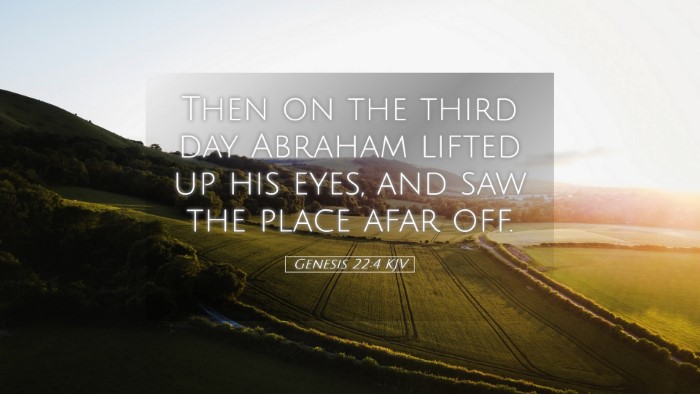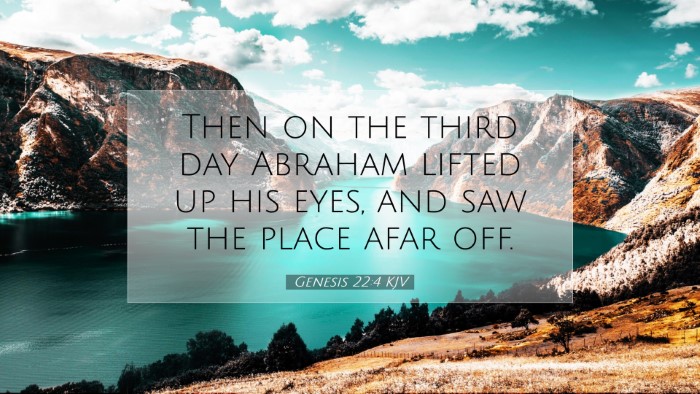Commentary on Genesis 22:4
Genesis 22:4 (KJV): "Then on the third day Abraham lifted up his eyes, and saw the place afar off."
Introduction
The passage from Genesis 22:4 depicts a significant moment in the narrative of Abraham's faith and obedience to God. This event, often referred to as the Akedah, or the Binding of Isaac, serves as a powerful testament to faith under extreme trials. In this commentary, we will explore insights drawn from various public domain commentaries to deepen our understanding of this pivotal scripture.
Abram's Journey of Faith
The journey of Abraham to mount Moriah is marked by profound spiritual significance. As Matthew Henry notes, Abraham's journey encapsulates both a physical and spiritual pilgrimage. The “three days” mentioned in the text are not only a temporal measure but also a period of reflection and anticipation, where the weight of the impending sacrifice weighed heavily upon him.
The Significance of Time
Albert Barnes emphasizes the importance of the number three in biblical narrative, associating it with completion and preparation. The three days may symbolize the preparation of Abraham's heart to submit to God's will. This delay before the climactic encounter serves to illustrate the depth of Abraham's commitment and the nature of divine testing.
Vision and Faith
Upon reaching the third day, the text states that Abraham "lifted up his eyes" and saw the place mentioned by God. Adam Clarke reflects on this act of lifting the eyes, interpreting it as a profound act of faith. Abraham, recognizing the place where he was to offer Isaac, demonstrates a faith that sees beyond the immediate pain to the purposes of God. This moment underscores the need for believers to lift their spiritual vision above their current circumstances.
The Place of Sacrifice
- Mount Moriah: It is essential to note the specific geographical reference, as it lays the groundwork for later biblical events, including the eventual site of the Jerusalem Temple. This convergence of sacrifice connects the Old and New Testaments, revealing God's redemptive plan.
- Affliction and Obedience: Henry points out that the place 'afar off' highlights both the physical distance and the emotional burden Abraham carried. The place of sacrifice often involves a journey filled with affliction, yet it is a necessary pathway to obedience.
- Prophetic Foreshadowing: The event foreshadows the ultimate sacrifice of Jesus Christ. As Barnes notes, just as God provided a ram in place of Isaac, so too has He provided Christ as the Lamb for His people.
Lessons for Believers
The narrative of Genesis 22:4 offers several key lessons for pastors, students, theologians, and scholars:
- The Nature of Faith: Faith often requires traversing difficult paths before arriving at divine revelations. Abraham's trust in God despite his fears serves as an encouragement for believers facing their own trials.
- Divine Provision: The journey to Moriah illustrates God's faithfulness. Just as He provided for Abraham, He also provides for His people today. Faith is often about trusting in God's provision long before we see the outcome.
- Preparing for Sacrifice: Each journey to a place of sacrifice requires preparation. The three-day journey reflects how God often asks us to wait and seek deeper understandings before facing our challenges.
- Vision in Trials: Lifting our eyes in times of distress can open our hearts to God's presence. Reflecting on Clarke's insights allows believers to remember that God is always present, even when we are surrounded by uncertainty.
Conclusion
Genesis 22:4 is not merely an account of Abraham's obedience; it is a profound statement about divine testing, sacrifice, and the nature of faith. By examining this scripture through the lens of public domain commentaries, we gain a richer understanding of the implications of Abraham's actions. For modern believers, it serves as a timeless reminder that true faith often requires a journey filled with challenges, reflection, and ultimately, a vision of God’s purpose in our lives.


